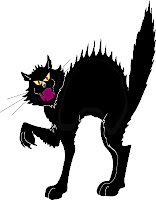Halloween Is Almost Here. Since early September the stores
have been filled with candy packaged in special Halloween wrapping, spooky
witch and ghost decorations, pumpkins waiting to be carved into Jack
O'Lanterns, and costumes for both children and adults. These have now been
picked over with what remains having been put on sale at drastically reduced
prices. Retailers have already moved on to Christmas.
I've collected several bits and pieces about ghosts,
goblins, and things that go bump in the night that I'd like to share with
you—starting with the ancient origins of the Halloween holiday then a bit of
Jack O'Lantern trivia.
The roots of Halloween date back 2000 years to the ancient
Celtic festival of Samhain (pronounced sow-in, rhymes with cow). The Celts lived in what is now Ireland,
United Kingdom, and northern France.
They celebrated their new year on November 1, the day marking the end of
summer and the harvest and the beginning of the dark winter. They believed that on the night before the
new year, the boundary between the worlds of the living and the dead wasn't
clearly defined. On the night of October
31 they celebrated Samhain, a time when they believed the ghosts of the dead
returned to earth.
To commemorate the event, the Druids (Celtic priests) built
large sacred bonfires where the people made sacrifices to the Celtic
deities. During the celebration, the
Celts wore costumes and attempted to tell each other's fortunes. When the celebration was over, they re-lit
their hearth fires from the sacred bonfire to help protect them during the
winter.
By 43A.D., the Romans had conquered most of the Celtic
territory. During the next four hundred
years, the Roman festivals of Feralia and Pomona were combined with the
traditional celebration of Samhain. In
the seventh century, Pope Boniface IV declared November 1 to be All Saints'
Day. It's believed today that the pope
was trying to replace the Celtic festival with a church sanctioned
holiday. The celebration was also called
All-Hallows. So, the night before it,
the night of Samhain, was called All-Hallows Eve.
In 1000A.D., the church declared November 2 as All Souls'
Day, a day to honor the dead. It was
celebrated similarly to Samhain with big bonfires, parades, and dressing up in
costumes. Together the three
celebrations—the eve of All Saints', All Saints', and All Souls'—were called
Hallowmas and eventually Halloween.
Halloween has always been a holiday filled with mystery,
magic, and superstition. It began as a
Celtic end-of-summer festival during which people felt especially close to
deceased relatives and friends. They set
places at the table and left treats on doorsteps for these friendly
spirits. They also lit candles to help
their loved ones find their way back to the spirit world. Today's Halloween ghosts are commonly
depicted as much scarier and our emphasis on customs and superstitions more
horror related.
And speaking of superstitions…have you ever wondered about
where these strange beliefs came from?
British author Harry Oliver wrote a book titled Black Cats and Four-Leaf Clovers where he explored the origins of
superstitions and old wives' tales from around the world. Here are a few of his observations.
Black Cats Bring Bad
Luck: black cats have been linked to
black magic and the ancient concept of witchcraft through the centuries which
is why many people think they're unlucky.
If a cat crosses your path, it's considered unlucky. However, if a cat walks toward you, it's a
good omen.
Carrots Are Good For
Your Eyesight: although studies have
shown that the vitamin A in carrots is good for your eyes, the vegetable isn't
enough to create 20/20 vision. Many
believe that it was a smart attempt by parents to get their children to eat
their vegetables. There is another
belief that it started during World War II.
It was rumored that British pilots were eating huge amounts of carrots
so they could see from high altitudes and in the dark. The rumor was created to keep the public from
discovering that radar had been invented and was being used against the enemy.
Wear Your Underwear
Inside Out: when you're having a bad
day, superstition says that if you turn your underwear inside out things will
get better. No one is sure where this
one came from, but it sounds like the result of a wild college fraternity
party.
In Ireland and Scotland, people began to make their own
versions by carving scary faces into turnips and potatoes, and in England they
used large beets. Immigrants from these
countries brought the tradition with them to the United States where they soon
found that pumpkins made the perfect Jack O'Lantern.
Do you have a favorite costume this year? Are you planning on going to a party? Leave me a comment about your Halloween
plans.





























4 comments:
Very cool! We're not doing much for Halloween this year. I was sort of uninspired. But next year I'll get back to it.
I love the Celtic roots of Halloween. And their belief in death as the "Other Side" a realm very close to ours. I do hate taht the holiday has been "demonized" by fundamentalist Christians who abhor its pagan roots. As if they (the Christians) didn't steal almost everything in their religion from other ancient cultures.
Jennifer: Same here, nothing special for Halloween this year.
Thanks for your comment.
Mary: Very true. The Christian church was unable to do away with the pagan holidays/celebrations so they 'modified' them to suit the church. Many (possibly most) of our holidays (other than the obvious of U.S. related holidays such as Independence Day, Presidents Day, etc.) are derived from pagan celebrations.
Thanks for your comment.
Post a Comment